Legacy of the Tropical Bengal Jute Trade is Left on Cold, Remote Dundee
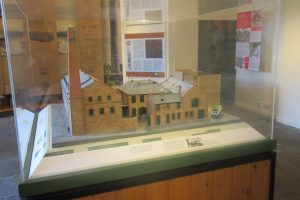
A model of the Verdant Works factory as it still is today
By Jawahar Malhotra
DUNDEE, SCOTLAND: As you exit from the small, nondescript ScottRail train station into the chill, drizzly grey day, across Riverside Drive and the A85 motorway, the hexagonal Discovery Point Museum and exhibition hall catches your eye, and the high masts of the RSS Discovery berthed besides it. A marvel of engineering and the craftsmanship of 19th century Dundee that made this once major whaling center a shipbuilding hub, the Discovery set sail on August 6, 1900 on its maiden voyage to the South Pole under the command of Lt. Robert Falcon Scott who is immortalized as the first to attempt to reach the continent’s center, later dying there in 1912. The Discovery was returned to its home in Dundee in April 1986.
Just next to it, soon-to-open in September 2018, is the Victoria & Albert Museum of Design, a $120 million dazzling architectural structure inspired by Scotland’s cliffs, though some say it is reminiscent of a whaling ship. Designed by Japanese architect Kengo Kuma, it is the latest landmark for the city as it attempts to transform after a deep slumber of a few decades into a tourist destination. Across the motorway, the semicircular 10-story Sleeprz Dundee Hotel, still under construction, will dominate the city’s new Waterfront District, at the southern corner of the center of town.
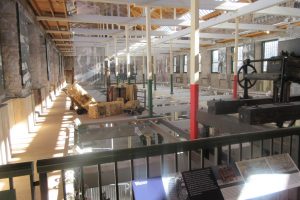
A great room where machines once worked nosily and now has one working display model, has been converted to a performance hall
It is the beginning of a remarkable transformation for a town that locals say was dormant and sleepy just a few short years ago. The running story-line for locals is that Dundee is known for its “three J’s”: jute, journalism and jams and all three figure into the lure for tourists, although you might add the Scotch distilleries like Edradour which lies 75 minutes to the northwest outside the picturesque village of Pitlochry in the Highlands.
The jams come from the fruit pastures on the lush hillsides and journalism is an outcome of the publishing business established by the D.C. Thomson company in 1905, still headquartered here in the original Courier Building at Meadowside. In a bow to literary and intellectual pursuits, Dundee also has four seats of higher learning: the University of Dundee founded in 1881 and ranked within the top 300 universities in the world and within the top 30 in the UK; Abertay University, Dundee College and the University of Dundee School of Medicine.
Jute brings in an entirely different angle from a grittier epoch of this town’s history and shows how far and wide the effect of British Colonialism was. In fact, the cargo ship Banglar Urmi from Bangladesh arrived in Dundee docks in October 1998 to discharge the last 310 tons of bales of raw jute. According to a recent encounter with a woman who has deep roots in the jute industry, by the end of this summer, the remaining spinning and weaving machines will have been dismantled and shipped to Bangladesh for reassembly in that nation’s jute business.
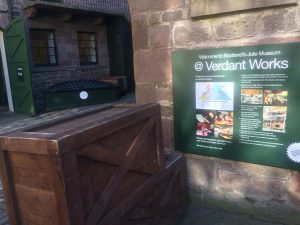
Verdant Works is now a Scottish Heritage site that depicts the tale of jute and life of old Dundee
The history of jute in Dundee has its roots in the deep tradition of weaving that existed in this Scottish town back to the 16th century and was easily adapted to jute weaving. The local whaling fleets provided the whale oil needed to soften the jute and Dundee’s shipbuilding industry made the big ships to bring the jute from India. When huge worldwide markets were opening up for jute products like yarn, rope, bags, canvases and tarps that were needed for the California Gold Rush, the Slave Trade with the New World and bags for cotton in America, mining for coal in Europe and to transport grains and gunpowder for the European wars, especially during World War I.
Local merchants quickly recognized the potential and opportunity and went to work to import the raw yarn from a captive source, the British colony of India and the East India Company headquartered in Calcutta, Bengal where the fiber was plentiful. The first 20 bales of jute unloaded in Dundee in 1820 and changed the destiny of the city forever. Between 1841 and 1901, the population of Dundee tripled from 45,000 to 161,000. In 1883 over 1 million bales of raw jute were unloaded and by the turn of the century, more than 50,000 people were employed in over 100 mills all clustered just to the south of Dundee Law Hill.
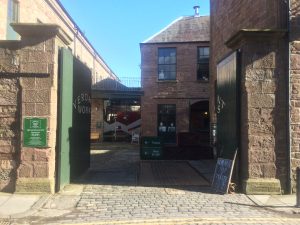
The entrance gate to the Verdant Works factory museum
The rush for jute products spawned many Jute Barons who built mansions and estates, while the workers worked in dangerous, noisy and particulate laden factories for meager wages. Many lost limbs and developed lung diseases, and often the children worked alongside the mothers, as a weaving job was not considered masculine enough for men who would stay home. Many of the workers were from Ireland and the Highlands who lived in slums. By 1885 the factory unions were formed and some Barons invested in parks, libraries and swimming pools for the city.
By 1870, India was starting to become a competitor for jute processing and in 1900, Calcutta overtook Dundee as the world’s biggest single jute manufacturer. During World War II, the number of workers was down to 25,000 and there was severe unemployment. By the early 1900s, Dundee was down to three jute spinners and one weaving plant. Still, through modernization, Dundee had a high production well into the 1960s.
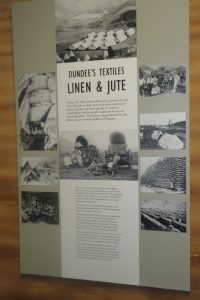
At Verdant Works, the history of the jute trade industry is vividly displayed
But the end came with the advent of a new fiber – polypropylene and soon most of the jute mills closed, though a handful switched and adapted. Now, most of the mills have converted to warehouses, nightclubs and housing, and the Dundee Mosque is even located in the area. One of the mills has become a museum – the Verdant Works – of the time in Dundee’s history owed to the natural fiber from India.
